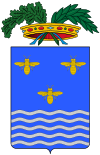Province of Terni
| Province of Terni | ||
|---|---|---|
| Province | ||

Palazzo Bazzani in Terni, the provincial seat.
|
||
|
||
 Map of the province. |
||
| Country |
|
|
| Region | Umbria | |
| Capital(s) | Terni | |
| Comuni | 33 | |
| Government | ||
| • President | Leopoldo Di Girolamo | |
| Area | ||
| • Total | 2,122 km2 (819 sq mi) | |
| Population (28 February 2016) | ||
| • Total | 228,236 | |
| • Density | 110/km2 (280/sq mi) | |
| Time zone | CET (UTC+1) | |
| • Summer (DST) | CEST (UTC+2) | |
| Postal code | 05010-05018, 05020-05026, 05028-05032, 05034-05035, 05039, 05100 |
|
| Telephone prefix | 075, 0744, 0763 | |
| Vehicle registration | TR | |
| ISTAT | 055 | |
The Province of Terni (Italian: Provincia di Terni) is the smaller of the two provinces in the Umbria region of Italy, comprising one-third of both the area and population of the region. Its capital is the city of Terni. The province came into being in 1927, when it was carved out of the original unitary province of Umbria.
The province of Terni has an area of 2,122 km², and a total population of 228,836 (2016). There are 33 comunes (Italian: comuni) in the province.
In June 2006, the only comunes with a population over 10,000 were Terni, Orvieto, Narni and Amelia.
It is bordered to the north with the Province of Perugia, to the east, south and west with the Lazio (Province of Rieti and Province of Viterbo) and to north-west with the Tuscany (Province of Siena). The province extends into the south-west of the Umbria region, occupying the last section of the Nera River valley near the confluence with the Velino River, and the eastern part of the valley of the Tiber River.
The province of Terni is characterized by its slopes encountered along the path of rivers, allowing the exploitation of hydro catchment areas, so as to have led to the creation of several artificial lakes:
In the 2nd millennium BC the province was occupied by a population called Umbri, who founded the cities of Amelia, Narnia Nahars, Otricolum and Interamna Nahars. With the development of the Etruscan civilization, their territory was reduced to the valleys of the Black and Velino. One of the most important and richest Etruscan cities in Province of Terni was Orvieto and an unidentified place called Fanum Voltumnae. For centuries, Umbrian and Etruscan fought hard for the rule of the Tiber valley, until, in 299 BC when Roman legions began the invasion of Umbria.
...
Wikipedia

